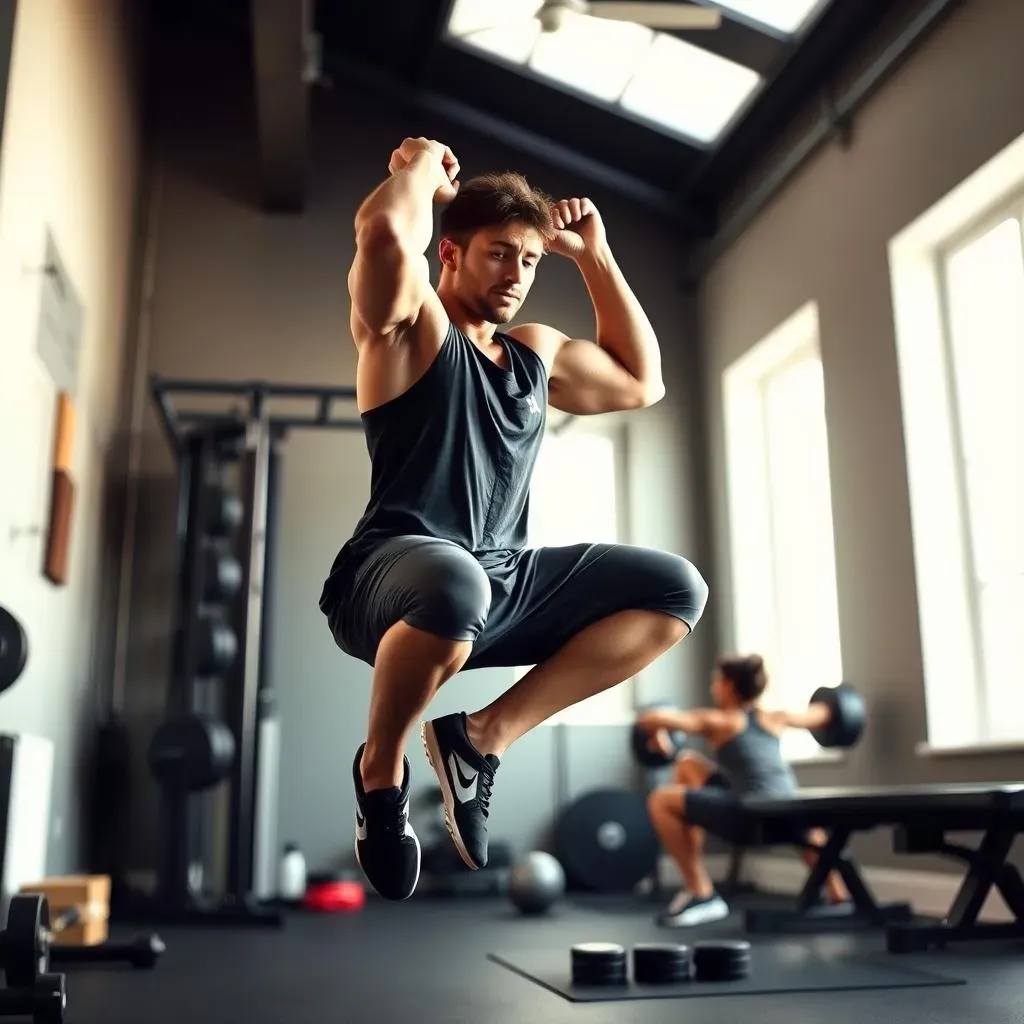Table of Contents
Ever wondered if ditching the gym and using your own body for a workout is actually effective? Well, you're in the right place! We're diving headfirst into the world of calisthenics, a form of exercise that's as old as time but still packs a serious punch. Forget fancy equipment and expensive memberships. Calisthenics uses your own body weight to build strength, endurance, and flexibility. But, the big question remains: is calisthenics healthy? This article will break down the benefits, show you how to get started, and address any concerns you might have. We'll explore how this super convenient workout can fit into anyone's life, regardless of fitness level. You’ll learn that it's not just about push-ups and squats; it's about building a strong, healthy you. So, get ready to discover how calisthenics can change your fitness game for the better. Let's jump in!
Why Calisthenics Is a Smart Move for Your Health

Why Calisthenics Is a Smart Move for Your Health
The Convenience Factor: Workout Anywhere, Anytime
Let’s be real, life gets hectic. Gym memberships can feel like a chore, and sometimes, just getting out of the house is a battle. Calisthenics? It’s your fitness sidekick, ready to go whenever you are. No equipment? No problem! Your body is the only tool you need. Whether you're in your living room, a park, or even a hotel room, a great workout is always within reach. This makes it super easy to stay consistent, which, let's face it, is half the battle when it comes to fitness. Plus, think of all the time you'll save not having to travel to a gym. More time for, well, everything else!
Adaptable to Every Body
Calisthenics isn't a one-size-fits-all deal; it's more like a choose-your-own-adventure. Whether you're just starting your fitness journey or you're a seasoned athlete, you can tailor calisthenics to your current level. Beginners can modify exercises like push-ups on their knees or wall squats, and as you get stronger, you can progress to more challenging variations. This makes it an incredibly inclusive form of exercise. It's not about keeping up with the Joneses; it’s about your personal progress and making strength gains at your own speed. You are in charge of your workout!
Fitness Level | Exercise Modification | Progression |
|---|---|---|
Beginner | Knee Push-ups, Wall Squats | Regular Push-ups, Full Squats |
Intermediate | Regular Push-ups, Lunges | Decline Push-ups, Jump Lunges |
Advanced | Pistol Squats, Handstand Push-ups | One-Arm Push-ups, Muscle-Ups |
Efficiency and Effectiveness: More Bang for Your Buck
Don't let the simplicity fool you; calisthenics is a powerhouse when it comes to building strength and endurance. You’re not just lifting weights; you're moving your entire body, which engages multiple muscle groups at once. This makes your workouts incredibly efficient. Even short sessions can deliver significant results. Think about it, a few sets of squats, push-ups, and planks can get your heart rate up and build muscle faster than you might think. It's about working smarter, not harder. Plus, it’s awesome for improving your balance, coordination, and overall body awareness. It's like a full-body upgrade using only what you've already got.
Getting Started: A Simple Calisthenics Routine for All Levels

Getting Started: A Simple Calisthenics Routine for All Levels
Warm-Up: Get Your Body Ready
Before you jump into any workout, especially calisthenics, you gotta warm up properly. Think of it like prepping your car before a long drive; you wouldn't just crank the engine and go, right? A good warm-up gets your muscles ready for action, reduces the risk of injury, and improves performance. Start with some light cardio, like a few minutes of brisk walking or jumping jacks. Then, do some dynamic stretches—arm circles, leg swings, and torso twists will do the trick. The goal is to get your blood flowing and your joints moving. Don't rush this part; it's crucial for a safe and effective workout.
I remember once, I skipped my warm-up and went straight into a set of push-ups. Let's just say my shoulders weren't happy with me the rest of the day. Lesson learned: always warm up!
Sample Exercises: Your Calisthenics Starter Pack
Alright, let’s get into some basic moves. These exercises are great for beginners, but they can be modified to suit different fitness levels. We're talking simple, effective movements that build a solid foundation. Start with knee lifts to get your core going, followed by half squats to work those legs. Then, try kneeling push-ups—they're easier on the upper body but still build strength. Side lunges with knee lifts are great for balance and mobility, and lastly, a plank with knee drops is excellent for core strength. Don't worry about doing a ton of reps at first. Focus on good form over quantity. Quality over quantity, always!
Exercise | Reps | Sets | Focus |
|---|---|---|---|
Knee Lifts | 10-15 | 2 | Core Activation |
Half Squats | 10-15 | 2 | Leg Strength |
Kneeling Push-ups | 8-12 | 2 | Upper Body Strength |
Side Lunges with Knee Lifts | 8-12 (per side) | 2 | Balance and Mobility |
Plank with Knee Drops | 30 seconds | 2 | Core Strength |
Listen to Your Body: It's Your Best Coach
This is super important: pay attention to what your body is telling you. If something feels painful, stop! It’s better to take a break than to push through and risk an injury. Make sure you're working within a pain-free range of motion. Don't lock your joints—keep them slightly bent. This reduces the stress on your joints and helps you move more fluidly. Also, don't forget to rest between sets. Your muscles need time to recover. It’s not a race, it’s a journey. Consistency is key, but so is rest and recovery. The American College of Sports Medicine suggests limiting strength workouts to two or three times per week, with rest days in between. That advice isn't just for weightlifting, it applies to calisthenics too.
I remember trying to go too hard too soon and I ended up with a sore wrist for a week. Since then, I’ve learned to listen to my body, and you should too.
Is Calisthenics Healthy? Listening to Your Body and Staying Safe

Is Calisthenics Healthy? Listening to Your Body and Staying Safe
Progressive Overload: The Secret to Getting Stronger
So, you've got the basics down, that’s great! Now, how do we keep making progress? This is where progressive overload comes in. It's a fancy term that simply means gradually increasing the demands on your body over time. In calisthenics, this can mean a few things. You can increase the number of reps you do, the number of sets, or the difficulty of the exercise. For example, if you're doing push-ups on your knees, you might try doing them on your toes once you feel ready. Or, if you're doing regular squats, you could try adding a pulse at the bottom of each squat. The key is to challenge yourself without overdoing it. Listen to your body, and increase the intensity when you feel you're ready.
I remember when I first started, I could barely do five push-ups on my knees. Now, I can crank out a set of regular push-ups, it's crazy what a little consistency and progressive overload can do for you.
Modifications and Variations: Keep it Fresh and Fun
One of the coolest things about calisthenics is the sheer number of modifications and variations you can do. This is awesome because it keeps things interesting and prevents boredom. If you're finding a particular exercise too easy, you can always make it harder. If you're struggling, you can always modify it to make it more manageable. For example, if you can do a set of ten regular push-ups easily, you can try doing decline push-ups. If a full squat is too tough, you can do a box squat or a wall squat. There are countless ways to adjust the exercises to suit your current fitness level and goals. Don't be afraid to experiment and find what works best for you. It's all about making fitness work for your body, not the other way around.
Exercise | Easier Variation | Harder Variation |
|---|---|---|
Push-ups | Knee Push-ups | Decline Push-ups |
Squats | Wall Squats | Pistol Squats |
Plank | Plank on Knees | Plank with Leg Lift |
Rest and Recovery: The Unsung Heroes
so you're crushing your workouts, that's great! But, don't forget about the importance of rest and recovery. Your body needs time to repair and rebuild muscle tissue after a workout. If you don't give it that time, you're going to increase your risk of injury and burnout. Make sure you're getting enough sleep, eating a balanced diet, and taking rest days. It’s not just about how hard you work, but also how well you recover. Think of it like this: your muscles grow when you rest, not when you workout. So, give yourself the time and space to recover and you'll be amazed at how much progress you’ll make.
I used to think that working out every day was the key to success, but I learned the hard way that rest days are just as important. Now, I make sure to take at least one or two rest days a week, and my body thanks me for it.
When to Seek Help: Don't Ignore the Red Flags
As much as I love calisthenics, it's important to know when to seek help from a professional. If you're experiencing persistent pain, discomfort, or any other issues, it's important to consult a doctor or physical therapist. They can assess your situation and provide guidance on how to safely continue your fitness journey. It's better to be safe than sorry. Don't try to diagnose yourself or push through pain. That's not being tough, that's being foolish. Your health and well-being should always be your top priority. If something doesn’t feel right, please seek professional advice. It's okay to ask for help; it's actually a sign of strength.
I've had a few minor injuries over the years, and I always seek help from a professional to make sure I'm on the right track for recovery. It's a small investment with a huge return.
Wrapping Up: Is Calisthenics Healthy for You?
So, is calisthenics healthy? The short answer is a resounding yes! This bodyweight training method offers a fantastic way to boost your fitness, improve your strength, and increase your flexibility without the need for costly equipment. It's adaptable, convenient, and efficient, fitting into almost any lifestyle. Remember, consistency and proper form are key to avoiding injuries and seeing real results. Whether you're a seasoned athlete or just starting out, calisthenics can be a powerful tool in your health journey. So, get out there, find a safe space, and start moving. Your body will thank you for it.
